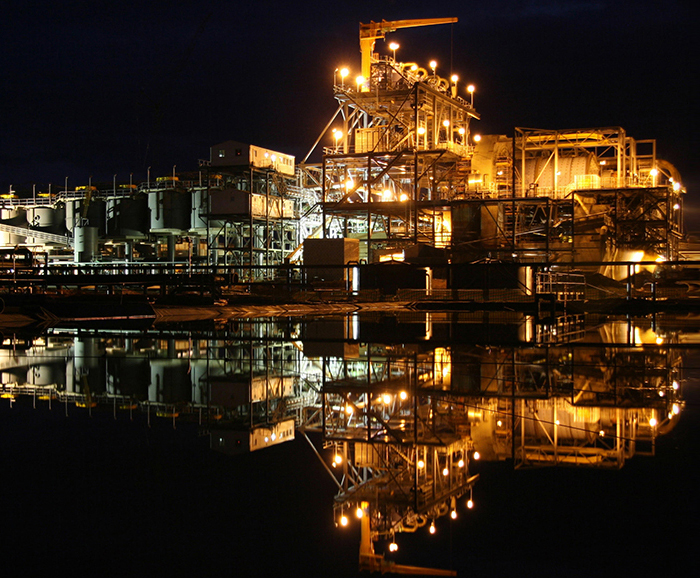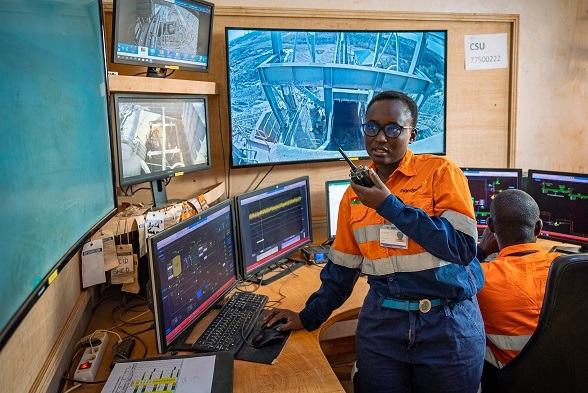
Located within one of the most prospective copper regions in the world, Barrick Gold’s Lumwana copper mine is one of Zambia’s best examples of a prosperous mining operation. Situated within a stable jurisdiction with a long history of mining and boasting established infrastructure, Lumwana possess a large, high potential copper deposit and a multi-decade reserve life.
Ore from Lumwana, which is predominantly sulphide, is treated through a conventional sulphide flotation plant, producing copper concentrate for smelting. On site, an extensive mining fleet and array of equipment can be found at work. This includes ten Sandvik DK45 drills, three Cubex DR560 drills, ten D10 track dozers, six CAT 16M motor graders, three 777 water trucks, three CAT 994/993 front end loaders, 31 Hitachi 4500 dump trucks and six Hitachi 5500 hydraulic shovels/excavators.
A 20MTPA design copper concentrator has been optimised to 24.5MTPA at the mine site. In 2013 Lumwana was responsible for producing approximately 260 million pounds of copper at an average copper recovery rate of 93.4 percent. Average concentrate grades for the year were recorded at 31.5 percent, while the processing cost was calculated at $3.53 per tonne. As of 31 December, 2013 proven and probable copper reserves at the mine were put at 6.6 billion pounds.
Copper concentrate from the mine is sold under long-term sales agreements to three smelters based in Zambia, Chambishi Copper Smelters, Konkola Copper Mines and Mopani. This concentrate is only sold on a domestic basis and is not subject to the ten percent duty imposed on all copper concentrate sold internationally. Furthermore, the long-term agreements the mine has in place help ensure that its fill production can be processed, meaning smelter capacity is not an issue for Lumwana.
Production at Lumwana in 2014 is currently projected to reach similar levels to that experienced in 2013. Meanwhile, the mine is pursuing a number of initiatives to further improve on cost reductions it has achieved to date. The mine has made significant cost savings through the optimising of its mine plan to smooth our annual stripping requirements, by rationalising contractor requirements and headcount, by in-sourcing maintenance labour and by renegotiating various key contracts. At the same time Lumwana’s management team have successfully improved fleet productivity by increasing LMC tonnage by 18 percent compared to 2012 and achieved efficiency improvements by reconfiguring the mine’s organisational structure and launching an improved Management Operating System. In total management believes that the aforementioned focused improvements all contributed to a $100 million cost reduction in 2013.
Today, approximately 90 percent of Lumwana’s workforce is Zambian, a figure that means that the mine falls in line with not only the country’s local employment plan, but also Barrick’s Community Relations Management System. Indeed Lumwana has a long history of working together with local communities in order to foster sustainable, long term success.
Examples of initiatives taken by the mine can be placed into three categories, those being health and safety awareness, education development and community infrastructure. In the first category the mine has provided vital support to the Lumwana Community HIV and AIDS Task Force, and has contributed towards road safety education, community-led water and sanitation, and gender-based violence awareness programmes.
On the educational side of things Lumwana supports countless community schools and public libraries, funds primary and tertiary education scholarships and has successfully maintained the on-site Lumwana Mine School since 2009. In recent years the mine has also provided assistance in the drilling of boreholes for clean water, the commissioning of by-pass roads for haul trucks, road safety awareness campaigns and population influx management.
Lumwana is also well regarded for its efforts towards fostering wealth creation. It has done so to date through the creation and support of enterprises promoting literacy in the community and the empowerment of women as earners and savers. Lumwana also supports several Agri-Food Innovation Partnerships as well as small and medium business development. In the latter it has put in place the Lumwana Business Incubator Programme as well as facilitating international joint venture investor brokering and Access to Finance partnerships.
Long before the turn of the year the mine identified a number of growth opportunities for 2014 which it continues to pursue as we speak. Again it has placed these opportunities into three separate categories, which are enabling people, process initiatives and what it calls its business improvement pipeline. In the first instance the mine plans to ensure its people are well supported through a combination of training and capacity building, and communications and change management.
In order to embed significant process improvements the mine has been working hard to streamline the shift handover process and enhancing the daily mine planning and review processes. It also plans to launch detailed project management best practices, which will assist in planning, delivering and tracking key 2014 priority projects, and identify the mine’s next wave of longer-horizon initiatives.
The new mine plan that Lumwana is working under is designed to maximise free cash flow in the current economic environment and preserve optionality. The goal of Lumwana’s management is to continue to improve the mine’s productivity at a time when the outlook for long term copper prices remains strong thanks to continued demand growth and supply-side challenges. What this collectively means for the mine is that it is very well positioned for what the future may bring.
Written by Will Daynes, research by Robert Hodgson



 Barrick-Lumwana-Africa-Mining-Jun14-Bro-s.pdf
Barrick-Lumwana-Africa-Mining-Jun14-Bro-s.pdf









